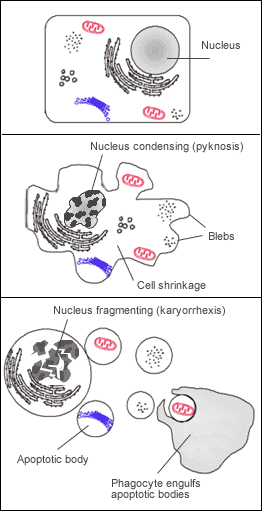Biology:Pyknosis
Pyknosis, or karyopyknosis, is the irreversible condensation of chromatin in the nucleus of a cell undergoing necrosis[1] or apoptosis.[2] It is followed by karyorrhexis, or fragmentation of the nucleus. Pyknosis (from Ancient Greek πυκνός meaning "thick, closed or condensed") is also observed in the maturation of erythrocytes (a red blood cell) and the neutrophil (a type of white blood cell). The maturing metarubricyte (a stage in RBC maturation) will condense its nucleus before expelling it to become a reticulocyte. The maturing neutrophil will condense its nucleus into several connected lobes that stay in the cell until the end of its cell life.
Micrograph of an infarct in the biliary tract, with pyknotic nuclei (arrows) (400x).
Pyknotic nuclei are often found in the zona reticularis of the adrenal gland. They are also found in the keratinocytes of the outermost layer in parakeratinised epithelium.
See also
References
- ↑ Robbins Basic Pathology (8th ed.). 2007. pp. 6, 9–10 (table 1-1).
- ↑ "Classification of cell death: recommendations of the Nomenclature Committee on Cell Death 2009". Cell Death and Differentiation 16 (1): 3–11. January 2009. doi:10.1038/cdd.2008.150. PMID 18846107.
 |



